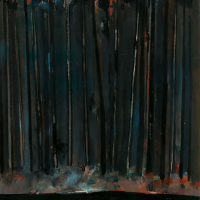61. FRED WILLIAMS

In 1956, Fred Williams returned from five years in England to embark upon a radical reappraisal of the Australian landscape. Hitherto, Williams art had largely concentrated on the human figure his whimsical etchings and drawings of the early to mid-1950s had featured the musicians, actors and circus performers of Londons West End. But from 1957-8, Williams began to realise the potential of the Australian landscape as a modernist subject as a vehicle for formal artistic invention.1 Unlike his immediate predecessors Sidney Nolan (1917-1992) and Arthur Boyd (1920-1999), Williams expressed little interest in the mythical or romantic qualities of the Australian bush: the outlaw on horseback was not for him. Likewise, Williams saw little appeal in naturalism for its own sake. His objective would be that of visual authenticity over mere description.
In dramatic contrast to the picturesque greenery of the English countryside, Williams observed an Australian landscape that was brown, flat and austere; devoid of any constructed focal point.2 Accompanied by this sense of Australias vastness, however, was Williams appreciation of the landscape on an intimate scale the minutiae of gumnuts, flaking tree bark and spinifex. As Sasha Grishin observes:
The implication of Fred Williams innovation was that he proposed an alternative way of seeing the landscape that took this contradiction into account, where we have the formal, flat structured outline contrasted with a precious complexity, irregularity and intricacy of detail.3
Mittagong c1958 is derived from one of Williams first painting expeditions upon returning to Australia, when in August 1957 he visited the Southern Highlands of New South Wales. The areas temperate eucalypt forests readily lent themselves to Williams favoured interpretation of the Australian landscape. As Patrick McCaughey explains, The bush motif was dense, crowded and tactile; it made for solid images and effects and it was spatially close and confined.4 The present work is a particularly refined example of these early Mittagong landscapes, distinguished by its schematic composition and strong verticality. Williams has flattened and simplified his bush subject to reveal a robust frieze of foliage. Individual trees appear as elongated lollipops, contrasted with horizontal bands of earth and water. Mittagong embodies the ready-made quality of Williams early paintings: the sense that he found the Australian landscape composed before him, ready for use.5
Wilsons Promontory dates from Williams visit to West Gippsland in May 1968,6 accompanied by his three daughters and wife Lyn. Having become intimately familiar with the landscapes of Sherbrooke, Upwey and Lysterfield near his home in the Dandenong Ranges, Williams sought to extend his painting vocabulary through new landscape subjects.7 Wilsons Promontory, on the south coast of Victoria, offered a variety of motifs from the granite boulders of Mount Oberon to the windswept coastal scrub extending to Bass Strait. Wilsons Promontory is closely related to a gouache of the same date and title in the National Gallery of Victoria (see Figure 1), and it is likely that both works resulted from the same painting expedition. The two works are characterised by their sombre, earthy palette and strong horizon line. Williams emphasises the flat monotony of the Australian landscape, rendered in broad horizontal bands of colour. As Simon Gregg observes, the gouaches that resulted from this visit are distinguished by their distant and monumental feel.8 Williams Gippsland paintings created during the course of repeated excursions to the region from 1968 to 1979 were the subject of a celebrated survey exhibition at the Gippsland Art Gallery in 2019.9
Painted roughly a decade apart, the two works presented here may be seen to bookend the evolution of Williams mature style. In the decade from 1958 to 1968, Williams would jettison descriptive modes of landscape painting to present a concise visual shorthand for the Australian bush an austere language of forms10 that could be readily interpreted and reimagined.
Footnotes:
1. Mollison, J., A Singular Vision: The Art of Fred Williams, Australian National Gallery, Canberra, 1989, p.35
2. Grishin, S., Australian Art: A History, The Miegunyah Press, Melbourne 2013, p.431
3. Ibid., p.433
4. McCaughey, P., Fred Williams, 1927-1982, Bay Books, Sydney, 1987, p.104
5. Mollison, J., op. cit., p.36
6. Lyn Williams, in email correspondence with the author, 16 October 2022
7. Stephens, A., Monumental Distance, Art Monthly, no.318, September 2019, p.16
8. Simon Gregg, quoted in ibid., p.16
9. Grand Country: Fred Williams in Gippsland, Gippsland Art Gallery, Victoria, 2019 (accessed October 2022): https://www.gippslandartgallery.com/exhibition/fred-williams-grand-country/
10. McCaughey, P., op. cit., p.187
Catherine Baxendale